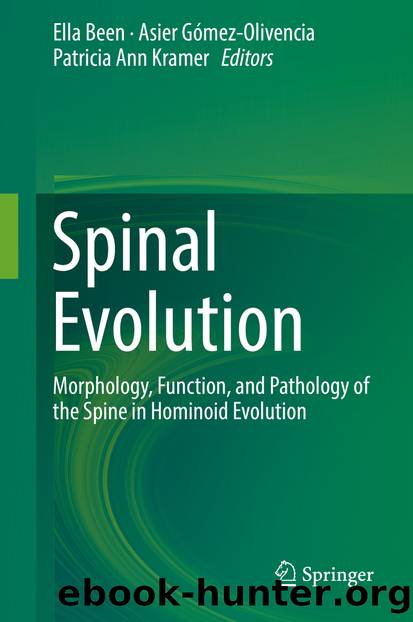Spinal Evolution by Unknown

Author:Unknown
Language: eng
Format: epub
ISBN: 9783030193492
Publisher: Springer International Publishing
9.4 Pre-MIS 3 Fossil Homo sapiens
The fossil record of the late Middle Pleistocene and Upper Pleistocene H. sapiens is relatively abundant (e.g., Dolní Vĕstonice, Pavlov, Cro-Magnon, Gough’s cave, El Mirón, Sunghir), and it is generally described as falling within the variation of recent H. sapiens (Vallois and Billy 1965; Sládek et al. 2000; Holliday 2006; Churchill and Holliday 2002; Been et al. 2010; Trinkaus et al. 2014; Carretero et al. 2015). However, older remains from our species are restricted to a handful of sites. Here, we will briefly enumerate the evidence from the Omo and Klasies River Mouth sites and discuss the vertebral remains from Skhul and Qafzeh.
The Omo valley (Ethiopia) has yielded one of the oldest Homo sapiens skeleton, the Omo I skeleton, dated around 195 ka (Pearson et al. 2008 and references therein). Seventeen vertebral fragments, including six cervical fragments, nine thoracic fragments, and two lumbar fragments, have been associated and, to our notice, just preliminarily described by Pearson et al. (2008).
The Klasies River main site is located between Plettenberg Bay and Cape St. Francis, on the southern coast of South Africa (Rightmire and Deacon 2001). The oldest (LBS) levels that have yielded two fragmentary human maxillae are dated to approximately 110 ka (MIS 5d), while most of the human remains have been recovered in the overlying (SAS) member with dates in excess of 90 ka (MIS 5c) (Grün et al. 1990). Rightmire and Deacon (1991) preliminarily described a lumbar vertebra (KRM 20927A/SAM-AP 6113A) from Cave 1 SAS member. Grine et al. (1998) provided evidence of an atlas (C1) fragment that had been identified among the faunal remains.
The Israeli site of Skhul is located in Nahal Mearot, adjacent to Tabun cave, on the western slopes of Mount Carmel, facing the Mediterranean Sea. The Skhul skeletons belong to H. sapiens dated around 100–135 ka (Stringer et al. 1989; Grün et al. 2005). Studies of their skeletal morphologies demonstrate close similarities to the hominins from Qafzeh cave in the Lower Galilee, Israel. At least four individuals from Skhul retain parts of their vertebral spine—Skhul 1, 4, 5, and 7. Skhul 5 is the most complete with an intact cervical spine (C1–C7) (Fig. 9.6), dorsal parts of the thoracic vertebrae T1–T12, and the lamina and transverse processes of the five lumbar vertebrae L1–L5 (McCown and Keith 1939). The main feature highlighted by McCown and Keith (1939) concerning the vertebral column of the Skhul individuals is related to the craniocaudal shortness of all the vertebral vertebrae, especially when the length of the long limbs is taken into account.
Fig. 9.6The cervical vertebrae of the fossil Homo sapiens Skhul 5. The asymmetry in the vertebral foramen of the C2 vertebra is artificial due to excessive erosion produced when the fossils were liberated from the matrix (Gómez-Olivencia, personal assessment). Note that the sixth (C6) and seventh (C7) cervical vertebrae are still connected via matrix, which makes it difficult to measure the orientation of the spinous process. cr = cranial; lat = lateral view
Download
This site does not store any files on its server. We only index and link to content provided by other sites. Please contact the content providers to delete copyright contents if any and email us, we'll remove relevant links or contents immediately.
Kathy Andrews Collection by Kathy Andrews(10500)
Thirteen Reasons Why by Jay Asher(7777)
The Red Files by Lee Winter(2907)
How to Do Nothing by Jenny Odell(2636)
The Genius of Japanese Carpentry by Azby Brown(2599)
Stacked Decks by The Rotenberg Collection(2266)
Tattoo Art by Doralba Picerno(2078)
Champions of Illusion by Susana Martinez-Conde & Stephen Macknik(2071)
The Art of Doom by Bethesda(1771)
The Artist's Way Workbook by Cameron Julia(1720)
Calligraphy For Dummies by Jim Bennett(1637)
Creative Character Design by Bryan Tillman(1553)
Botanical Line Drawing by Peggy Dean(1528)
One Drawing A Day by Veronica Lawlor(1494)
Wall and Piece by Banksy(1453)
The Art of Creative Watercolor by Danielle Donaldson(1450)
Art Of Atari by Tim Lapetino(1324)
Happy Hand Lettering by Jen Wagner(1320)
Artificial Intelligence for Games by Ian Millington & John Funge(1298)
